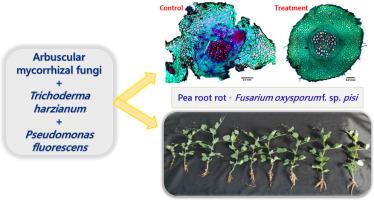Pesticide Biochemistry and Physiology ( IF 4.7 ) Pub Date : 2021-07-21 , DOI: 10.1016/j.pestbp.2021.104939 Hany H A El-Sharkawy 1 , Mohamed S Abbas 2 , Amira S Soliman 2 , Seham A Ibrahim 3 , Ibrahim A I El-Nady 1

|
Fusarium root rot caused by Fusarium oxysporum is an aggressive disease-causing damping-off, root rot, and vascular wilt in all peas growing fields. The disease can cause 100% yield losses under favorable conditions. The present study aims to control Fusarium root rot using Trichoderma harzianum, Pseudomonas fluorescens, and arbuscular mycorrhizal fungi, singly or in combinations. The results showed that all treatments significantly enhanced not only the plant growth, total phenol, activities of antioxidant enzymes, but also, the yield and seed quality. Several changes in the anatomical, physiological, and characteristics of the treated plants were also recorded. Compared to the untreated control treatment, under greenhouse conditions, the maximum reduction of the disease severity (80%) was achieved by the synergistic triple treatment consists of arbuscular mycorrhizal fungi, Trichoderma harzianum, and Pseudomonas fluorescens, as they gave the best growth and yield parameters. The same combination showed the highest activity of the antioxidant enzyme peroxidase (57.1%), as well as the highest total phenol content (117.7%), over the control. The synergistic triple increased the contents of protein (64.6%), total soluble sugars (48.5%), and total carbohydrate (24.8%) in seeds of pea compared with the control. The synergistic triple treatment led to an increase in the thickness of the root section (25%), the thickness of the cortex (24.8%), the thickness of the vascular cylinder (31.5%), and the diameter of the xylem vessels (81.5%) of the root. Based on their efficiency and eco-safety, this synergistic triple might be very effective for controlling root rot disease of pea caused by F. oxysporum, as well as improve the growth, yield, and seed quality.
中文翻译:

促生长微生物对尖孢镰刀菌生物防治的协同作用。sp. 豌豆植物的pisi、生长、产量、生理和解剖特征
镰刀菌引起的根腐病尖镰孢是一个积极的致病猝倒病,根腐病,并在生长领域的所有豌豆枯萎病。在有利条件下,该病害可导致 100% 的产量损失。本研究旨在利用哈茨木霉、荧光假单胞菌防治镰刀菌根腐病。,和丛枝菌根真菌,单独或组合。结果表明,所有处理不仅显着提高了植物生长、总酚、抗氧化酶的活性,而且显着提高了产量和种子质量。还记录了处理植物的解剖学、生理学和特征的若干变化。与未经处理的对照处理相比,在温室条件下,由丛枝菌根真菌、哈茨木霉和荧光假单胞菌组成的协同三重处理实现了疾病严重程度的最大降低 (80%),因为它们给出了最好的生长和产量参数。与对照组相比,相同的组合显示出最高的抗氧化酶过氧化物酶活性 (57.1%),以及最高的总酚含量 (117.7%)。与对照相比,三重协同增加了豌豆种子中蛋白质(64.6%)、总可溶性糖(48.5%)和总碳水化合物(24.8%)的含量。协同三联处理导致根部厚度(25%)、皮质厚度(24.8%)、维管圆柱体厚度(31.5%)和木质部血管直径(81.5%)增加。 %) 的根。基于它们的效率和生态安全性,这种协同三联可能对控制由F引起的豌豆根腐病非常有效。尖孢菌,以及改善生长、产量和种子质量。


























 京公网安备 11010802027423号
京公网安备 11010802027423号